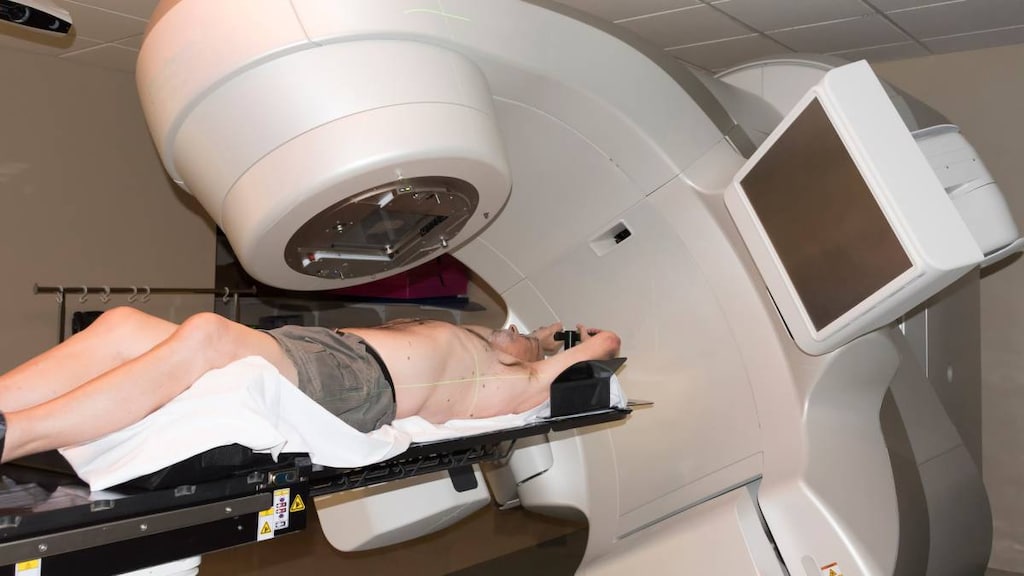Dosage Forms
Excipient information presented when available (limited, particularly for generics); consult specific product labeling.
Capsule, Oral, as phosphate sodium:
Emcyt: 140 mg
Pharmacology
Mechanism of Action
Estramustine is an estradiol and nornitrogen mustard carbamate-linked combination which has antiandrogen effects (due to estradiol) and antimicrotubule effects (due to nornitrogen mustard); it causes a marked decrease in plasma testosterone and an increase in estrogen levels.
Pharmacokinetics/Pharmacodynamics
Absorption
Incomplete (Bergenheim 1998)
Metabolism
Initially dephosphorylated in the GI tract, then hepatically oxidated and hydrolyzed to estramustine, estromustine (oxidized isomer of estramustine), estrone, and estradiol.
Excretion
Feces (primarily); urine (trace amounts) (Bergenheim 1998)
Time to Peak
2 to 3 hours (Bergenheim 1998)
Half-Life Elimination
Estromustine: 13.6 hours (range: 9 to 23 hours); Estrone: 16.5 hours (Bergenheim 1998)
Use in Specific Populations
Special Populations: Hepatic Function Impairment
Estramustine may be poorly metabolized in patients with hepatic impairment.
Use: Labeled Indications
See Use: Unsupported.
Contraindications
Hypersensitivity to estramustine, estradiol, nitrogen mustard, or any component of the formulation; active thrombophlebitis or thromboembolic disorders (except where tumor mass is the cause of thromboembolic disorder and the benefit may outweigh the risk)
Canadian labeling: Additional contraindications (not in the US labeling): Severe hepatic or cardiac disease
Documentation of allergenic cross-reactivity for estrogens is limited. However, because of similarities in chemical structure and/or pharmacologic actions, the possibility of cross-sensitivity cannot be ruled out with certainty.
Dosage and Administration
Administration
Estramustine is associated with a moderate emetic potential; antiemetics are recommended to prevent nausea and vomiting.
Oral: Administer on an empty stomach, at least 1 hour before or 2 hours after eating. Administer with water; do not administer with milk, milk-based products, or calcium products.
Dietary Considerations
Milk products and calcium-rich foods or supplements may impair the oral absorption of estramustine phosphate sodium.
Storage
Store at 2°C to 8°C (36°F to 46°F).
Drug Interactions
Baricitinib: Immunosuppressants may enhance the immunosuppressive effect of Baricitinib. Management: Use of baricitinib in combination with potent immunosuppressants such as azathioprine or cyclosporine is not recommended. Concurrent use with antirheumatic doses of methotrexate or nonbiologic disease modifying antirheumatic drugs (DMARDs) is permitted. Consider therapy modification
BCG (Intravesical): Immunosuppressants may diminish the therapeutic effect of BCG (Intravesical). Avoid combination
Calcium Salts: May decrease the absorption of Estramustine. Exceptions: Calcium Chloride. Consider therapy modification
Cladribine: May enhance the immunosuppressive effect of Immunosuppressants. Avoid combination
Clodronate: May increase the serum concentration of Estramustine. Monitor therapy
Coccidioides immitis Skin Test: Immunosuppressants may diminish the diagnostic effect of Coccidioides immitis Skin Test. Monitor therapy
Denosumab: May enhance the adverse/toxic effect of Immunosuppressants. Specifically, the risk for serious infections may be increased. Monitor therapy
Echinacea: May diminish the therapeutic effect of Immunosuppressants. Consider therapy modification
Fingolimod: Immunosuppressants may enhance the immunosuppressive effect of Fingolimod. Management: Avoid the concomitant use of fingolimod and other immunosuppressants when possible. If combined, monitor patients closely for additive immunosuppressant effects (eg, infections). Consider therapy modification
Leflunomide: Immunosuppressants may enhance the adverse/toxic effect of Leflunomide. Specifically, the risk for hematologic toxicity such as pancytopenia, agranulocytosis, and/or thrombocytopenia may be increased. Management: Consider not using a leflunomide loading dose in patients receiving other immunosuppressants. Patients receiving both leflunomide and another immunosuppressant should be monitored for bone marrow suppression at least monthly. Consider therapy modification
Lenograstim: Antineoplastic Agents may diminish the therapeutic effect of Lenograstim. Management: Avoid the use of lenograstim 24 hours before until 24 hours after the completion of myelosuppressive cytotoxic chemotherapy. Consider therapy modification
Lipegfilgrastim: Antineoplastic Agents may diminish the therapeutic effect of Lipegfilgrastim. Management: Avoid concomitant use of lipegfilgrastim and myelosuppressive cytotoxic chemotherapy. Lipegfilgrastim should be administered at least 24 hours after the completion of myelosuppressive cytotoxic chemotherapy. Consider therapy modification
Natalizumab: Immunosuppressants may enhance the adverse/toxic effect of Natalizumab. Specifically, the risk of concurrent infection may be increased. Avoid combination
Nivolumab: Immunosuppressants may diminish the therapeutic effect of Nivolumab. Consider therapy modification
Ocrelizumab: May enhance the immunosuppressive effect of Immunosuppressants. Monitor therapy
Palifermin: May enhance the adverse/toxic effect of Antineoplastic Agents. Specifically, the duration and severity of oral mucositis may be increased. Management: Do not administer palifermin within 24 hours before, during infusion of, or within 24 hours after administration of myelotoxic chemotherapy. Consider therapy modification
Pidotimod: Immunosuppressants may diminish the therapeutic effect of Pidotimod. Monitor therapy
Pimecrolimus: May enhance the adverse/toxic effect of Immunosuppressants. Avoid combination
Roflumilast: May enhance the immunosuppressive effect of Immunosuppressants. Consider therapy modification
Siponimod: Immunosuppressants may enhance the immunosuppressive effect of Siponimod. Monitor therapy
Sipuleucel-T: Immunosuppressants may diminish the therapeutic effect of Sipuleucel-T. Management: Evaluate patients to see if it is medically appropriate to reduce or discontinue therapy with immunosuppressants prior to initiating sipuleucel-T therapy. Consider therapy modification
Smallpox and Monkeypox Vaccine (Live): Immunosuppressants may diminish the therapeutic effect of Smallpox and Monkeypox Vaccine (Live). Monitor therapy
Tacrolimus (Topical): May enhance the adverse/toxic effect of Immunosuppressants. Avoid combination
Tertomotide: Immunosuppressants may diminish the therapeutic effect of Tertomotide. Monitor therapy
Tofacitinib: Immunosuppressants may enhance the immunosuppressive effect of Tofacitinib. Management: Concurrent use with antirheumatic doses of methotrexate or nonbiologic disease modifying antirheumatic drugs (DMARDs) is permitted, and this warning seems particularly focused on more potent immunosuppressants. Consider therapy modification
Trastuzumab: May enhance the neutropenic effect of Immunosuppressants. Monitor therapy
Upadacitinib: Immunosuppressants may enhance the immunosuppressive effect of Upadacitinib. Avoid combination
Vaccines (Inactivated): Immunosuppressants may diminish the therapeutic effect of Vaccines (Inactivated). Management: Vaccine efficacy may be reduced. Complete all age-appropriate vaccinations at least 2 weeks prior to starting an immunosuppressant. If vaccinated during immunosuppressant therapy, revaccinate at least 3 months after immunosuppressant discontinuation. Consider therapy modification
Vaccines (Live): Immunosuppressants may enhance the adverse/toxic effect of Vaccines (Live). Immunosuppressants may diminish the therapeutic effect of Vaccines (Live). Management: Avoid use of live organism vaccines with immunosuppressants; live-attenuated vaccines should not be given for at least 3 months after immunosuppressants. Exceptions: Smallpox and Monkeypox Vaccine (Live). Avoid combination
Adverse Reactions
Frequency not always defined.
>10%:
Cardiovascular: Edema (20%)
Endocrine & metabolic: Gynecomastia (75%), increased lactate dehydrogenase (2% to 33%), decreased libido
Gastrointestinal: Nausea (16%), diarrhea (13%), gastrointestinal irritation (12%)
Genitourinary: Breast tenderness (71%)
Hepatic: Increased serum AST (2% to 33%)
Respiratory: Dyspnea (12%)
1% to 10%:
Cardiovascular: Cardiac failure (3%), local thrombophlebitis (3%), myocardial infarction (3%), cerebrovascular accident (2%), pulmonary embolism (2%), chest pain (1%), flushing (1%)
Central nervous system: Lethargy (4%), insomnia (3%), emotional lability (2%), anxiety (1%), headache (1%)
Dermatologic: Pruritus (2%), xeroderma (2%), exfoliation of skin (1%), skin rash (1%), thinning hair (1%)
Endocrine & metabolic: Increased thirst (1%)
Gastrointestinal: Anorexia (4%), flatulence (2%), gastrointestinal hemorrhage (1%), sore throat (1%), vomiting (1%)
Hematologic & oncologic: Leukopenia (4%), bruise (3%), thrombocytopenia (1%)
Hepatic: Increased serum bilirubin (1% to 2%)
Neuromuscular & skeletal: Leg cramps (9%)
Ophthalmic: Lacrimation (1%)
Respiratory: Hoarseness (1%), rhinorrhea (1%)
<1%, postmarketing, and/or case reports: Anemia, angina pectoris, angioedema, cerebral ischemia, confusion, depression, decreased glucose tolerance, hypercalcemia, hypocalcemia, hypersensitivity reaction, hypertension, impotence, ischemic heart disease, myasthenia, venous thrombosis
Warnings/Precautions
Concerns related to adverse effects:
- Cardiovascular effects: Elevated blood pressure or congestive heart disease may occur. Estrogen treatment for prostate cancer is associated with an increased risk of thrombosis or MI (including fatalities). Use with caution in patients with a history of thrombophlebitis, thrombosis, or thromboembolic disease, especially if associated with estrogen therapy. Use with caution in patients with cerebrovascular disease or coronary artery disease.
- Endocrine effects: Estrogenic effects may decrease testosterone levels; may cause gynecomastia and/or impotence.
- Fluid retention: Peripheral edema (new onset or exacerbation) or congestive heart disease has been observed. Use with caution in patients where fluid accumulation may be poorly tolerated, including cardiovascular disease (HF or hypertension), migraine, seizure disorder or renal dysfunction.
- Gastrointestinal toxicity: Estramustine is associated with a moderate emetic potential; antiemetics are recommended to prevent nausea and vomiting.
- Glucose tolerance: Glucose tolerance may be decreased; use with caution in patients with diabetes mellitus.
- Hepatic effects: Liver enzyme and bilirubin abnormalities may occur; monitor during and for 2 months after treatment.
- Hypersensitivity: Allergic reactions and angioedema, including airway involvement, have been reported.
- Hypertension: May cause hypertension; monitor blood pressure periodically.
Disease-related concerns:
- Hepatic impairment: Use with caution in patients with hepatic impairment (estramustine may be metabolized poorly).
- Metabolic bone disease: Use with caution in patients with metabolic bone diseases (due to the effects on calcium and phosphorus homeostasis).
- Osteoblastic metastases: Patients with osteoblastic metastases are at risk for hypocalcemia; monitor calcium regularly.
- Renal impairment: Use with caution in patients with renal impairment.
Concurrent drug therapy issues:
- Drug-drug interactions: Potentially significant interactions may exist, requiring dose or frequency adjustment, additional monitoring, and/or selection of alternative therapy. Consult drug interactions database for more detailed information.
Other warnings/precautions:
- Limitation of use: A clinical practice guideline from the American Society of Clinical Oncology (ASCO) and Cancer Care Ontario recommends that estramustine not be offered to men with metastatic castration-resistant prostate cancer due to a lack of benefit in survival or quality of life (ASCO [Basch 2014]).
Monitoring Parameters
Monitor serum calcium, liver function tests (during and for 2 months following treatment), and serum glucose (in diabetic patients). Monitor blood pressure and fluid status. Monitor adherence.
Pregnancy
Pregnancy Considerations
Estramustine is not indicated for use in women. Some men who were impotent on estrogen therapy have regained potency while taking estramustine; effective contraception should be used for male patients with partners of childbearing potential.
Patient Education
What is this drug used for?
- It is used to treat prostate cancer. It may be given for other reasons. Talk with the doctor.
Frequently reported side effects of this drug
- Nausea
- Diarrhea
- Tender breasts
- Leg cramps
- Enlarged breasts
- Sexual dysfunction
Other side effects of this drug: Talk with your doctor right away if you have any of these signs of:
- High blood sugar like confusion, fatigue, increased thirst, increased hunger, passing a lot of urine, flushing, fast breathing, or breath that smells like fruit
- Electrolyte problems like mood changes, confusion, muscle pain or weakness, abnormal heartbeat, seizures, lack of appetite, or severe nausea or vomiting
- Severe cerebrovascular disease like change in strength on one side is greater than the other, difficulty speaking or thinking, change in balance, or vision changes
- Blood clots like numbness or weakness on one side of the body; pain, redness, tenderness, warmth, or swelling in the arms or legs; change in color of an arm or leg; chest pain; shortness of breath; fast heartbeat; or coughing up blood
- Severe dizziness
- Passing out
- Weight gain
- Edema
- Difficulty breathing
- Severe headache
- Vision changes
- Signs of a significant reaction like wheezing; chest tightness; fever; itching; bad cough; blue skin color; seizures; or swelling of face, lips, tongue, or throat.
Note: This is not a comprehensive list of all side effects. Talk to your doctor if you have questions.
Consumer Information Use and Disclaimer: This information should not be used to decide whether or not to take this medicine or any other medicine. Only the healthcare provider has the knowledge and training to decide which medicines are right for a specific patient. This information does not endorse any medicine as safe, effective, or approved for treating any patient or health condition. This is only a brief summary of general information about this medicine. It does NOT include all information about the possible uses, directions, warnings, precautions, interactions, adverse effects, or risks that may apply to this medicine. This information is not specific medical advice and does not replace information you receive from the healthcare provider. You must talk with the healthcare provider for complete information about the risks and benefits of using this medicine.




